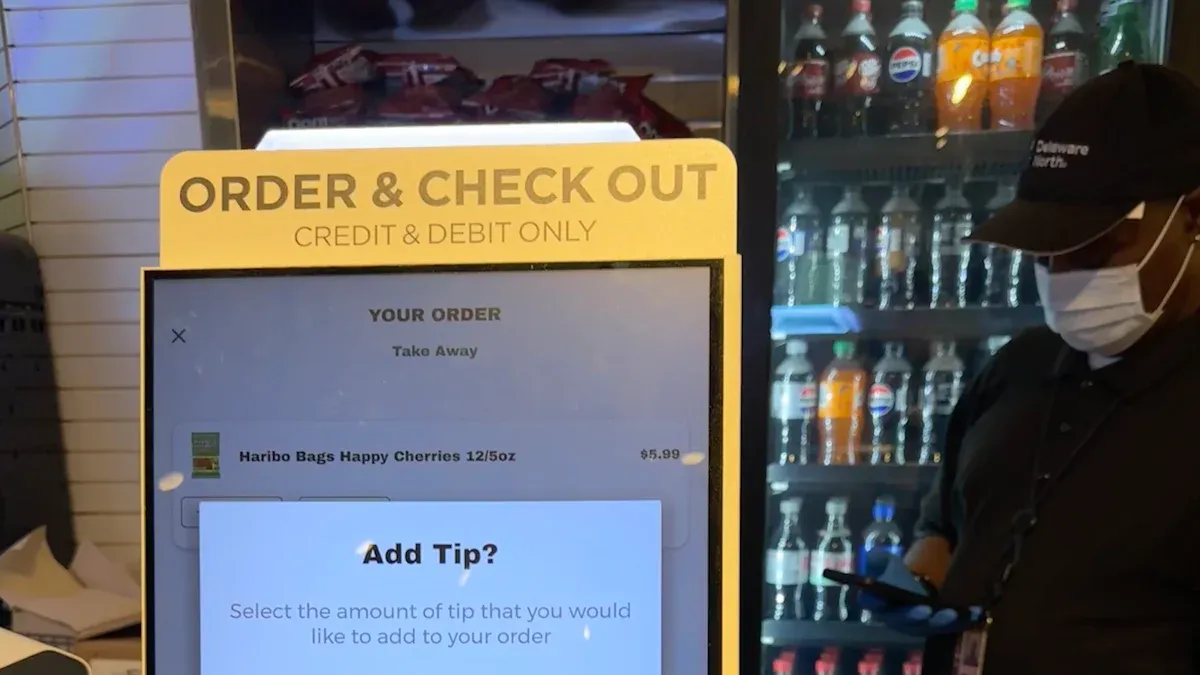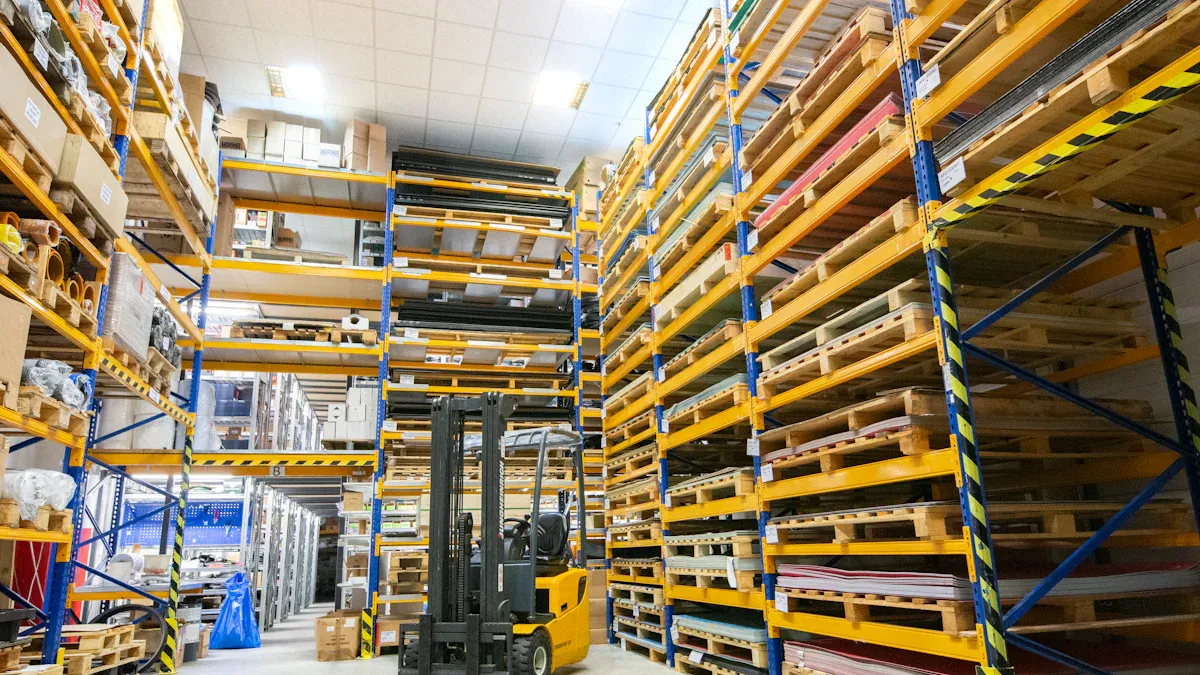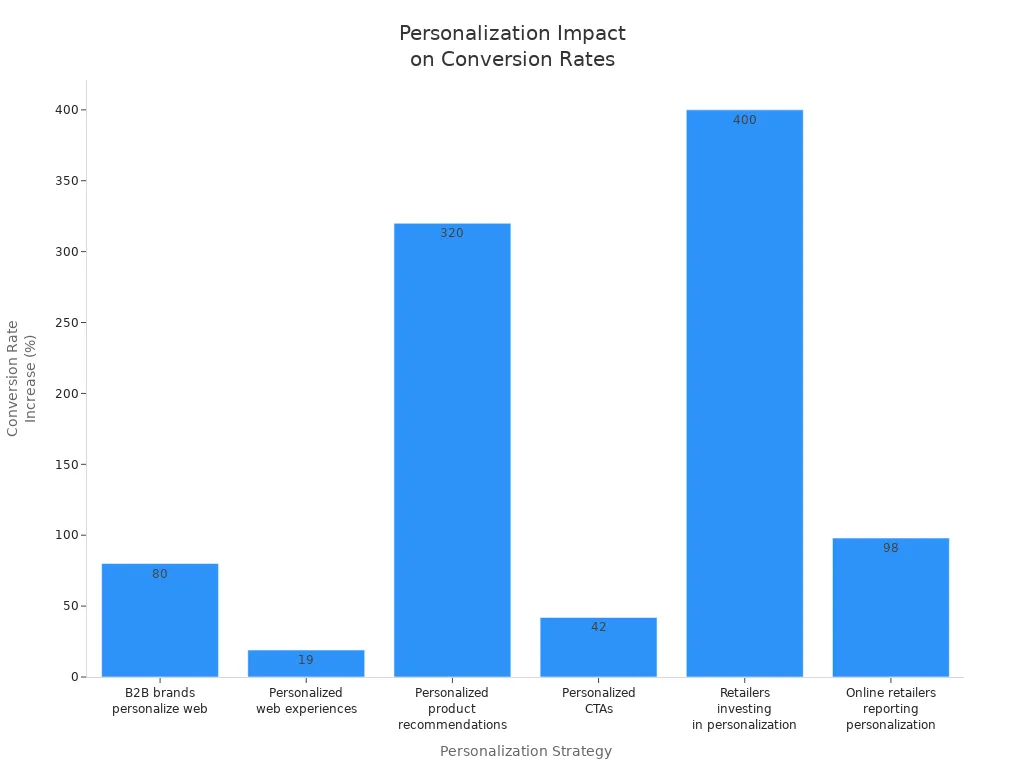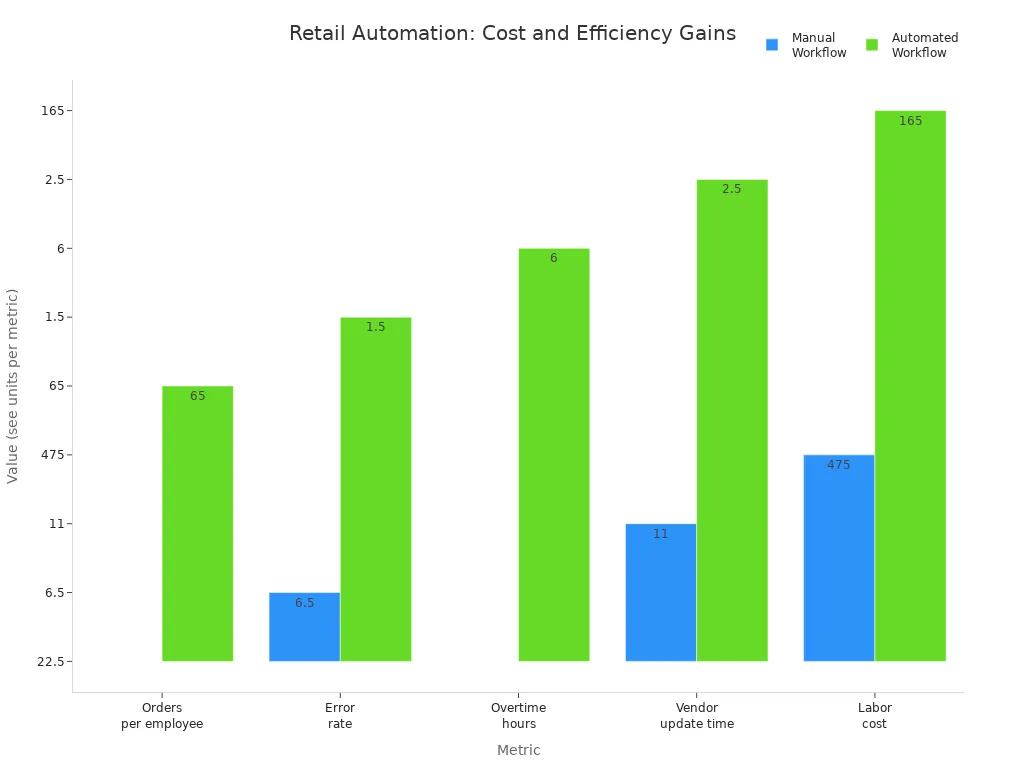How Leading Brands Are Using Automation in the Retail Industry

You see automation and AI changing how you shop every day. Leading Brands use smart tools like robots, self-checkout kiosks, and AI-driven inventory systems. More than 80% of retailers plan to boost their AI capabilities by 2025. These technologies help stores run smoothly, save money, and give you a better experience.
Automation Technology | Measurable Benefits |
|---|---|
Unified commerce platforms | |
Self-checkout kiosks | Reduced checkout times from up to 20 minutes to less than one minute, improved cash collection efficiency by 20%. |
AI-driven inventory management | Enhanced inventory accuracy and reduced stockouts through predictive analytics. |
Key Takeaways
Automation speeds up checkout and reduces wait times, allowing you to spend more time shopping and less time in line.
Smart technologies like AI and RFID help stores keep shelves stocked, ensuring your favorite items are always available.
AI chatbots provide instant support, making it easier for you to get answers and resolve issues quickly.
Personalized marketing offers tailored deals based on your shopping habits, increasing your chances of finding products you love.
While automation enhances efficiency, stores still prioritize human interaction for complex needs, ensuring a balanced shopping experience.
In-Store Automation

Self-Checkout
You see self-checkout stations in many stores today. Leading Brands like Walmart, Target, Kroger, and Walgreens use these systems to help you shop faster. Self-checkout lets you scan and pay for items by yourself. This technology reduces lines and wait times, so you spend less time in the store. One cashier can now watch several self-checkout stations at once, which helps stores use their staff more efficiently and lower costs.
Aspect | Benefit |
|---|---|
Efficiency | Self-checkouts cut down lines and wait times, making shopping smoother. |
Cost Reduction | Stores save money by having fewer cashiers at checkout. |
Self-checkout also improves your experience. You get to control your pace and avoid long queues. Stores notice that faster checkout leads to happier customers and more loyalty. However, some stores adjust their self-checkout strategies to balance technology with personal service. For example, Walmart sometimes adds more staffed lanes to improve service and reduce theft.
Tip: Positive experiences with self-checkout can make you want to return to the same store.
Smart Shelves
Smart shelves use sensors and RFID tags to track products in real time. Stores like Kroger and Walgreens rely on this technology to keep shelves stocked and organized. When a product runs low, the system sends an alert for restocking. This helps prevent out-of-stock problems and keeps your favorite items available.
Smart shelves update prices digitally, saving over 10,000 paper tags each year.
Changing 10,000 prices now takes only 60 seconds instead of 40 hours.
Real-time restocking can cut labor costs by up to 30%.
These shelves help stores avoid both empty shelves and overstocking.
Smart shelves also make shopping easier for you. You find what you need, and prices stay accurate. Stores benefit from better inventory management and higher profits. The global retail automation market keeps growing, showing that more stores want these solutions.
Supply Chain Automation

Automated Warehousing
You see automated warehousing changing how stores handle products. Leading Brands like Amazon, IKEA, Tesla, and DHL use advanced robots and smart systems to move, store, and pick items. These companies rely on technology to speed up their work and reduce mistakes.
Company | Technologies Used |
|---|---|
Amazon | Kiva robots, large robotic arms, various automated solutions |
IKEA | Automated storage and retrieval system with cranes |
Tesla | Autonomous indoor vehicles, heavy-duty robotic arms by Kuka and Fanuc |
DHL | Picking automation systems, fully automated crane systems, barcode and scanner automation |
Robots in warehouses work all day and night. They help you get your orders faster and make fewer errors. For example, Amazon uses Kiva robots to bring shelves to workers, which saves time and energy. IKEA uses cranes to move heavy items safely. These systems boost productivity and keep inventory organized.
Improvement Type | Measurement |
|---|---|
Fulfillment Speed | |
Order Picking Accuracy | Over 95% accuracy with robotic systems |
Productivity Increase | Continuous operation of robots boosts productivity |
You benefit from faster shipping and more accurate orders. Stores save money because robots do not need breaks and can work longer hours.
Delivery Robotics
Delivery robotics help stores bring products to your door quickly and safely. Many companies use robots for last-mile delivery, which is the final step in getting your order to you. These robots travel on sidewalks or roads and deliver packages right to your home.
Amazon Scout delivers small packages to porches and curbside stops in neighborhoods and on campuses.
Serve’s sidewalk units follow geofenced paths, avoid people and obstacles, and make deliveries more efficient.
Starship robots use smart path planning to make many stops and offer flexible delivery times.
Stores track how well these robots work by looking at on-time delivery rates, stop-to-stop times, robot use, energy use per package, and safety records. Using delivery robots can cut last-mile delivery costs by up to 20%. AI-driven route planning also reduces transport costs by 15–20%. Experts expect annual savings from robotics to reach $7.1 billion by 2032.
Note: Automated delivery helps you get your orders faster and supports safer, greener cities.
Customer Experience Automation
AI Chatbots
You interact with AI chatbots every day, often without realizing it. Leading Brands use these smart assistants to answer your questions, help with orders, and solve problems quickly. You get instant support, even late at night or on weekends. Here are some ways top retailers use AI chatbots to improve your experience:
Best Buy uses a virtual assistant for order management. This tool has reduced call center volume by 40% and lets you solve problems on your own.
Decathlon UK’s chatbot, DECA, handles 65% of customer questions and reaches a 96% satisfaction rate.
1-800-Flowers keeps you updated on your orders through Facebook Messenger.
H&M’s chatbot helps you return items by creating digital labels and guiding you step by step.
Sephora’s chatbot gives you personalized product suggestions and answers order questions.
AI chatbots make your shopping easier and faster. They can cut resolution times by up to 50% and reduce first response times by 37%. About 80% of customers say they have a positive experience after using AI-powered support. You get answers right away, which means less waiting and more satisfaction.
Tip: For simple questions or tracking orders, try using a store’s chatbot. You might get help faster than calling customer service.
Personalized Marketing
Personalized marketing uses automation to send you offers and messages that match your interests. Leading Brands study your shopping habits and use this data to create special deals just for you. This approach helps you find products you like and increases your chances of making a purchase.
Metric | Value |
|---|---|
10% | |
Boost in sales through personalization | 20% |
Higher transaction frequencies with automation | 6x |
Stores use automated marketing flows to welcome new shoppers, reactivate old customers, and reward loyal buyers. You might get a special discount on your birthday or a reminder about items left in your cart. These strategies make you feel valued and keep you coming back.
Personalized marketing leads to higher sales and better conversion rates. For example, B2B brands that personalize their websites see an 80% increase in conversion rates. Personalized product recommendations can boost conversions by 320%. Most online retailers report higher order values when they use personalization.

Note: Personalized offers and recommendations help you discover new products and save money.
Data-Driven Decisions
Predictive Analytics
You see predictive analytics shaping how stores make smart choices every day. Retailers use data to understand what you want and when you want it. By looking at past sales, stores can guess which products will be popular next month. This helps them keep shelves stocked and avoid waste. You get your favorite items more often, and stores save money.
Stores use customer data to group shoppers by age, interests, and buying habits.
You receive offers that match your style because stores know what you like from your past purchases.
Real-time pricing data helps stores set prices that fit your budget and expectations.
Companies like Sephora, Target, Costco, and Amazon use these tools to give you a better shopping experience. You notice that your favorite products rarely run out, and you get deals that feel personal.
Business Outcome | Description |
|---|---|
Stores find out why shoppers leave and work to keep you coming back. | |
Optimized Inventory Management | Stores spot trends early and stock up before products become popular. |
Stores use insights to make work faster and smoother. | |
Better Demand Forecasting | Stores predict what you will buy, so they order the right amount of products. |
Tip: Stores that use predictive analytics can offer you more choices and better deals.
Dynamic Pricing
Dynamic pricing changes prices based on demand and inventory. You might notice prices go up during busy times or drop when stores have extra stock. This helps stores stay competitive and gives you fair prices.
Dynamic pricing can boost revenue by 10–25% in just six months. Algorithms make sure prices never fall below what stores need to make a profit. During big sales, stores use dynamic pricing to grow average order value by up to 13%. You benefit from discounts when stores want to clear inventory, and stores protect their profit margins.
Evidence | Description |
|---|---|
Revenue Growth | Stores see a 10–25% lift in revenue with dynamic pricing. |
Margin Management | Dynamic pricing stops over-discounting and keeps profits safe during sales. |
Note: Leading Brands use dynamic pricing to balance great deals for you with strong profits for their business.
Leading Brands and Automation
Key Benefits
You see automation changing retail in many ways. Stores use smart tools to make shopping faster and easier for you. Here are some of the biggest benefits you notice:
Automation speeds up checkout and reduces wait times. You spend less time in line and more time shopping.
RFID technology tracks products in real time. Stores keep shelves stocked and avoid running out of your favorite items.
AI-driven inventory systems cut down on waste and lower costs. Stores use smart logistics to move products quickly and efficiently.
Automation updates inventory levels instantly. This reduces mistakes and keeps products available for you.
By handling simple tasks, automation lets workers focus on helping you and solving problems.
You get quick and accurate service. Personalized recommendations make your shopping experience better.
IoT systems help stores save energy, which lowers costs and helps the environment.
Stores do more with the same number of workers. This means better service and more productivity.
You can see these benefits in the numbers. The table below shows how automation improves efficiency and saves money:
Metric | Manual Workflow | Automated Workflow | Efficiency Gain |
|---|---|---|---|
Orders processed per employee/hour | 20–25 | 60–70 | 3x increase |
Error rate (order inaccuracies) | 5–8% | 1–2% | 60–70% reduction |
Average overtime hours/month | 20–25 | 5–7 | 70% reduction |
Time on vendor updates/order checks | 10–12 hrs/week | 2–3 hrs/week | 75% reduction |
Labor cost per 1,000 orders | $450–500 | $150–180 | 65% reduction |

You also see big changes in how stores work:
McKinsey & Company found that automation can cut supply chain costs by 20–30 percent.
PwC reports up to 35 percent fewer errors in order fulfillment.
Deloitte says automation can reduce cycle times by 40–60 percent.
Gartner predicts that over 75 percent of retail supply chains will use automation by 2026.
When you shop at stores run by Leading Brands, you notice faster service, fewer mistakes, and more choices. Automation helps stores give you a better experience while saving money and time.
Challenges
You may wonder if automation is always easy for stores. Many face big challenges when they try to use new technology. Here are some of the main problems:
Many workers and managers fear change. They worry about learning new systems or losing their jobs.
Some stores do not see a quick return on their investment. High costs at the start can make automation hard to afford.
Poor data quality can stop AI and automation from working well.
Some leaders resist new ideas. A lack of innovation slows down progress.
New data laws make it hard to use customer information safely.
Automation can make shopping feel less personal. You might miss talking to real people.
Data security and privacy are big concerns. Stores must protect your information from hackers.
Adding new systems to old ones can be complex and expensive.
You see that stores must balance technology with human service. The table below shows how stores try to keep this balance:
Evidence Type | Description |
|---|---|
Automation Benefits | AI chatbots answer simple questions 24/7, making service faster for you. |
Human Interaction | Real people help with complex problems, showing empathy and understanding. |
Balancing Strategy | Stores map your journey to decide when to use automation or human help. |
Stores also train workers in skills like empathy and problem-solving. This helps you feel valued, even when you use self-checkout or chatbots.
Note: Automation changes how stores work. You see new jobs that need tech skills, like managing robots or analyzing data. The AI services market in retail is growing fast, from $5 billion to over $31 billion by 2028. This means more stores will use smart tools, and workers will need new skills.
You notice that Leading Brands use automation for many tasks:
AI predicts what you want to buy and helps stores stock the right products.
Robots pick and pack items in warehouses, making online shopping faster.
AI sets prices and plans store layouts to boost sales.
You see more stores using automation every year. The global retail automation market could reach $44.8 billion by 2030. New trends like cashier-less stores, delivery robots, and AI-powered assistants will shape your shopping experience. As automation grows, stores must keep finding ways to blend technology with the human touch you value.
You see Leading Brands using automation and AI to make shopping easier, faster, and more personal.
Automation boosts efficiency by handling repetitive tasks and tracking inventory in real time.
You enjoy better service and lower prices as stores cut costs and reduce errors.
Customer satisfaction rises with personalized experiences and quick support.
Business operations run smoother with fewer mistakes.
You get faster, more tailored service.
Stores grow profits by saving time and money.
As more stores invest in AI, you can expect even smarter shopping, but stores must keep training workers and protecting your data.
FAQ
What is retail automation?
Retail automation uses technology like robots, AI, and smart software to handle tasks in stores and warehouses. You see it in self-checkout, smart shelves, and chatbots. Automation helps stores work faster and serve you better.
How does automation affect store workers?
You may notice fewer cashiers, but stores need more tech support and customer service roles. Workers learn new skills to manage robots and help shoppers. Automation changes jobs but does not always remove them.
Is my personal data safe with automated systems?
Stores use strong security tools to protect your data. You should check privacy policies before sharing information. Most brands follow strict rules to keep your details safe.
Will automation make shopping less personal?
You still get help from real people for complex needs. Automation handles simple tasks, so staff can focus on you. Many stores use both technology and human service to give you a better experience.
See Also
Transforming Online Store Management With AI-Driven Tools
The Future of Retail Lies in AI-Driven Stores
Smart Technology: The Revolution of Electronics Vending Machines
Essential Insights on AI-Enhanced Corner Stores for Retailers
Revolutionizing Retail Accessibility Through Grocery Vending Machines
